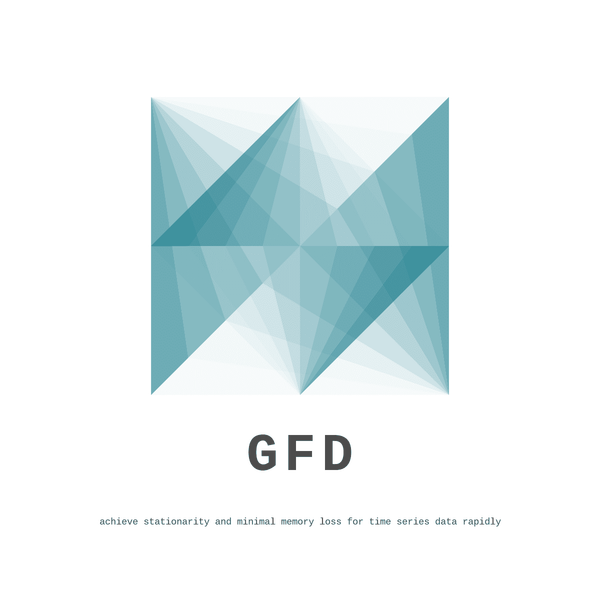ritchieng / Fractional_differencing_gpu
Programming Languages
Projects that are alternatives of or similar to Fractional differencing gpu
Fractional Differencing with GPU (GFD)


This is a GPU implementation of fractional differencing (we call it GFD). It allows rapid large-scale implementation of fractional differencing to minimize memory loss while achieving stationary for time series data.
Experiment Our Code Instantly Now on Google Colaboratory
Easily run the whole tutorial in a self-contained Jupyter Notebook on Google Colaboratory by pressing the button above. The whole process of including pulling all data, dependencies and running the code for GFD is contained in the notebook, allowing you to run this notebook as is.
Summary Results
Number of data points and time taken in seconds. You can easily reach such similar multipliers on Google Colab or on more powerful machines via GCP, AWS or your local servers/machines.
| **** | 100k | 1m | 10m | 100m |
|---|---|---|---|---|
| GCP 8x vCPUs | 9.18 | 89.62 | 891.24 | 9803.11 |
| GCP 1x T4 GPU | 1.44 | 1.33 | 3.75 | 29.88 |
| GCP 1x V100 GPU | 0.93 | 1.07 | 3.17 | 23.81 |
| Speed-up 1x T4 vs 8x vCPUs | 6.38x | 67.38x | 237.66x | 328.08 |
| Speed-up 1x V100 vs 8x vCPUs | 9.87x | 83.76x | 281.15x | 411.72x |
Optimized Version by NVIDIA
Full credits to NVIDIA where they built on our work and further speed things up resulting in almost 10000x speed-up over a CPU implementation. You can find the more complex and less intuitive but highly performance version of GFD by NVIDIA in this notebook.
Simple GFD Function
We've created a simple function in the notebook, pass your Pandas dataframe into the function and it will return fractionally differenced time series dataframe.
Arguments
-
d: fractional differencing value, 0 means no differencing, above 1 means integer differencing, and anything between 0 to 1 is fractional differencing. -
floor: minimum value to ignore for fixed window fractional differencing.
Notes
- Your dataframe (
df_raw) is required to have an index such that it's from lag k (oldest time) to lag 0 (latest time) from top to the bottom of the dataframe accordingly for this function to work appropriately.- Future: We will implement auto-fixes moving forward such that you don't have to care about the order of your dataframe, but just take in the mean time.
- We tested for dataframes up to 100 million data points per function call (per dataframe essentially).
GPU implementation
gfd, weights = frac_diff_gpu(df_raw, d=0.5, floor=5e-5)
CPU implementation
fd, weights = frac_diff(df_raw, d=0.5, floor=5e-5)
Important Links to Presentation and Code Repository
- Code Repository: https://github.com/ritchieng/fractional_differencing_gpu
- Presentation: https://www.researchgate.net/publication/335159299_GFD_GPU_Fractional_Differencing_for_Rapid_Large-scale_Stationarizing_of_Time_Series_Data_while_Minimizing_Memory_Loss
- HTML Notebook (easy reading on mobile, collaboration with deep learning wizard): https://www.deeplearningwizard.com/machine_learning/gpu/gpu_fractional_differencing/
GFD Repository Plans
- Make GFD more efficient
- Chunk size implementation: currently just throwing the entire chunk matching the size of the dataset's length (haha).
- Run GFD on thousands of time series datasets, creating a grid of t-stats and time benchmarks.
- Package GFD functions into a pip package for quick running
Release Notes
The next release will include multiple 1D blocks in a 1D grid instead of a single 1D block of 518/1024 threads. This will help users understand multiple blocks vs a single block.
Beyond the next release, we'll be moving to explain the use of more than 1 dimension blocks/grids.
Citation Reference to Repository/Presentation
If you use the code, please cite using this link alongside Prado/Hosking papers.
Credits and Special Thanks
- NVIDIA (Ettikan, Chris and Nick), Amazon AWS, ensemblecap.ai, and NExT++ (NUS School of Computing)
- Marcos Lopez de Prado for his recent push on the use of fractional differencing of which this guide is based on.
- Hosking for his paper in 1981 on fractional differencing.
Help Wanted
- Feel free to raise any issue for feedback on bugs or improvements.
- I'll be implementing more critical GPU-accelerated functions, we are looking for collaborators.
- If you find this repository useful, please star it!

